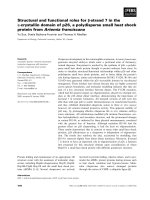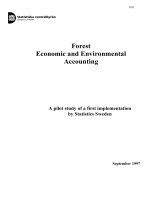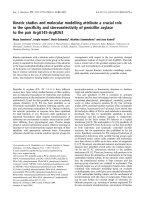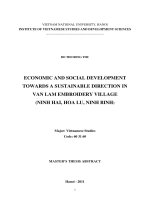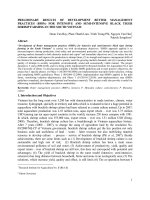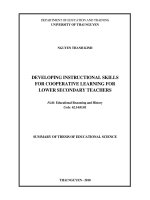Summary of Doctoral dissertation Economics: Economic and environmental efficiency of intensive shrimp farming in the coastal transforming areas of the Mekong delta
Bạn đang xem bản rút gọn của tài liệu. Xem và tải ngay bản đầy đủ của tài liệu tại đây (689.03 KB, 37 trang )
MINISTRY OF EDUCATION AND TRAINING
CAN THO UNIVERSITY
SUMMARY OF DOCTORAL DISSERTATION
Major: Agricultural economics
Code: 9620115
NGUYEN THUY TRANG
ECONOMIC AND ENVIRONMENTAL
EFFICIENCY OF INTENSIVE SHRIMP
FARMING IN THE COASTAL
TRANSFORMING AREAS OF
THE MEKONG DELTA
Can Tho, 2020
The research has been finished at Can Tho University, Can
Tho City, Vietnam
Supervisors
- The main instructor: Assoc. Prof. Dr. Huynh Viet Khai
- Secondary instructor: Dr. Tran Minh Hai
The dissertation will be defended at the council of the school
level at:………………………………………………………
On:…………hour…….. date……month……..year……….
Discussant 1:
Discussant 2:
Citing of this dissertation is available at following the libraries:
- Learning Resource Center-Can Tho University, Can Tho City
- Vietnam National Library, HCM City
LIST OF PUBLISHED PAPERS RELATED TO THE
DISSERTATION
1. Nguyen Thuy Trang, Huynh Viet Khai, Vo Hong Tu, Tran
Minh Hai, 2019. Theoretical and empirical frameworks for
measuring environmental efficiency in agricultural production:
A case study of shrimp farming in transforming areas of Kien
Giang province. Journal of Science Ho Chi Minh City Open
University, 14 (1/2019), Pp. 115-125.
2. Nguyen Thuy Trang, Huynh Viet Khai, Vo Hong Tu, 2018.
Economic efficiency of shrimp farming in the coastal areas of
Soc Trang province. Can Tho University Journal of Science, 07
(54), Pp. 146-154.
3. Nguyen Thuy Trang, Huynh Viet Khai, Vo Hong Tu,
Mitsuyasu YABE, 2018, The determinants behind changes of
farming systems and adaptation to salinity intrusion in the
coastal regions of Mekong Delta. Journal of Faculty of
Agriculture, Kyushu University, 63, Pages 417-422
4. Nguyen Thuy Trang, Huynh Viet Khai, Vo Hong Tu, Nguyen
Bich Hong, 2018. Environmental efficiency of transformed
farming systems: a case study of change from sugarcane to
shrimp in the Vietnamese Mekong Delta. Forestry Research and
Engineering: International Journal, 02, Pages 54-60
i
LIST OF CONTENTS
LIST OF TABLE ........................................................................... iv
LIST OF FIGURE .......................................................................... v
CHAPTER 1: INTRODUCTION .................................................. 1
1.1 RATIONALE OF THE DISSERTATION ............................. 1
1.2 OBJECTIVES ........................................................................... 3
1.2.1 General objectives ............................................................ 3
1.2.2 Specific objectives ........................................................... 3
1.3 RESEARCH QUESTIONS ...................................................... 4
1.4 RESEARCH SUBJECTS ......................................................... 4
1.5 SCOPE OF THE STUDY ......................................................... 4
CHAPTER 2: LITERATURE REVIEW ..................................... 5
2.1 REVIEW OF NEW TECHNOLOGY ACCEPTANCE
MODEL AND FARMING TRANSFORMATION ..................... 5
2.2 REVIEW ABOUT ECONOMIC EFFICIENCY ................... 6
2.3 REVIEW ABOUT ENVIRONMENTAL EFFICIENCY ..... 7
2.4 REVIEWS OF FACTORS AFFECTING EFFICIENCY .... 9
CHAPTER 3: THEORY AND RESEARCH METHODOLOGY
......................................................................................................... 10
3.1. THEORETICAL CONCEPTS ............................................. 10
3.1.1 Intensive farming ........................................................... 10
3.1.2 Factors affecting changes in farming systems ............... 10
3.1.3 Economic efficiency and measurement methods ........... 11
3.1.4. Environmental efficiency and measurement method .... 11
ii
3.2. RESEARCH METHODOLOGY ......................................... 12
3.2.1. Theoretical framework .................................................. 12
3.2.2 Selection of study sites................................................... 13
3.2.3. Analytical methods ....................................................... 13
CHAPTER 4: RESULT AND DISCUSSION............................. 15
4.1 STATUS OF CHANGES IN FARMING SYSTEMS TO
SHRIMP......................................................................................... 15
4.1.1 Status of changes in farming systems ............................ 15
4.1.2. Factors affecting changes in farming systems to shrimp
................................................................................................. 16
4.2. ECONOMIC AND ENVIRONMENTAL EFFICIENCY OF
TRANSFORMED INTENSIVE SHRIMP FARMING ............. 17
4.2.1. Economic efficiency of intensive shrimp farming ........ 17
4.2.1.1 Estimation of economic efficiency ............................. 17
4.2.1.2 Factors affecting economic efficiency ........................ 21
4.2.2 Environmental efficiency of intensive shrimp farming . 22
4.2.2.1 Estimation of environmental efficiency ...................... 22
4.2.2.2 Factors affecting environmental efficiency ................ 26
4.3. IMPLICATIONS FOR IMPROVING ECONOMIC AND
ENVIRONMENTAL EFFICIENCY .......................................... 28
4.3.1. Solutions for shrimp farmers ........................................ 28
4.3.2. Solutions from local authorities .................................... 28
CHAPTER 5: CONCLUSION..................................................... 29
iii
LIST OF TABLE
Table 4.1: Logit results of factors affecting changes in farming
systems ............................................................................................ 16
Table 4.2: Estimated results of translog variable cost frontier ....... 18
Table 4.3: Economic efficiency of intensive shrimp farming......... 19
Table 4.4: Estimated results of translog production frontier .......... 23
Table 4.5: Output-oriented technical efficiency ............................. 24
Table 4.6: Environmental efficiency of intensive shrimp ............... 25
Table 4.7: Tobit results of factors affecting environmental efficiency
......................................................................................................... 26
iv
LIST OF FIGURE
Figure 3.1: Theoretical framework of the study ............................. 12
Figure 4.1: Trends in changes of farming systems in Soc Trang and
Kien Giang ...................................................................................... 15
Figure 4.2: Observed and possible minimum cost in Soc Trang .... 20
Figure 4.3: Observed and possible minimum cost in Kien Giang .. 21
v
CHAPTER 1: INTRODUCTION
1.1 RATIONALE OF THE DISSERTATION
Climate change has been happening more and more seriously such
as weather variability and salinity intrusion (Carew-Reid, 2008;
Nhan et al., 2011; Wassmann et al., 2004). The climate change
together with market instability, low selling prices while rising input
prices have caused changes of farming activities as an inevitable
phenomenon to adapt (Binh et al., 2009; Clayton, 2003).
The Mekong Delta (MD) is considered as the core region for
agricultural production and aquaculture, contributing more than
90% of rice exports and more than 70% of fishery stocks (GSO,
2013). Recently, many farmers in the Mekong Delta’s coastal areas
have shifted their production activities to intensive shrimp farming,
especially white-legged shrimp. According to the report of the
Institute of Fisheries Economics and Planning (2015) and the
Ministry of Agriculture and Rural Development (2019), the total
area of brackish shrimp farming in the Mekong Delta in 2018
reached 679,152 ha with an average growth rate of 2.1%/year from
2005-2018. Of which white-legged shrimp farming area increased
more than 17 times during the period of 2008-2018, namely from
4,747 hectares in 2008 to 78,392 hectares in 2018. The province
having the highest growth rate of white-legged shrimp area is Soc
Trang with an average growth rate of up to 116.83%/year; while the
remaining provinces having the medium growth rates such as Kien
Giang 36.24%/year and Bac Lieu 13.47%/year.
However, the process of agricultural transformation requires high
investment and good preparation of production techniques as well as
the market outlets, so the risk of the conversion process is quite high
(Le Anh Tuan et al. , 2014; World Bank, 2016). According to the
World Bank (2016), shrimp farming is one of the production
activities that have a significant impact on the water environment
1
and generate high greenhouse gas emissions due to the excessive
use of inputs. Therefore, it is necessary to measure economic and
environmental efficiency with a scientific approach for intensive
shrimp farming in coastal transforming areas.
In terms of economic efficiency, so far many studies have been
conducted by using the profit or cost frontier function to measure
efficiency. In particular, some case studies using the profit function
include Pham Le Thong et al (2011); Nguyen Van Tien and Pham
Le Thong (2014); Pham Le Thong and Nguyen Thi Phuong (2015);
Nguyen Minh Hieu (2014). Some other studies using cost frontier
include Ferrier and Lovell (1990); Worthington (2000); Rosko
(2001); Coelli, et al. (2005); Tu & Trang (2015). However, the
above-mentioned studies only considered economic efficiency as
the profit/cost frontier function by a two-step approach and did not
investigate the causes of transformation as well as the inefficient use
of the inputs towards cost minimization by one-step model. In
addition, these studies using Cobb-Doughlas and DEA (Data
Envelopment Analysis) methods make it impossibly to separate the
noise effects apart from inefficiency effects and to investigate the
causes of inefficiency. In addition, many studies show that farmers
do not use input resources effectively, so it is necessary to consider
the ability to reduce production costs (Dung & Dung, 1999;
Kompas, 2004; Khai & Yabe, 2011; Hoang Linh, 2012; Kompas et
al., 2012).
Regarding to environmental efficiency, Pittman (1983) is probably
considered to be the first to concern about environmental issues
when estimating the efficiency for production activities. In this
study, the author considered the environmental aspect as an
unexpected output from production process. The author modified
the estimated index from the term "translog multilateral productivity
index" proposed by Caves et al. (1982). Färe et al. (1989) proposed
the term enhanced hyperbolic productive efficiency measure. This
term considers simultaneously the difference among the maximum
2
equiproportional increase in desirable outputs, the maximum
equiproportional decrease in undesirable outputs and the maximum
equiproportional decrease in inputs. However, the study measured
productive efficiency using nonparametric approach (DEA), which
cannot separate noise effect apart from deterministic frontier. In
addition, measuring undesirable output in agricultural production is
a difficult task. In order to overcome the drawbacks of the previous
studies, Reinhard et al. (1999) treated environmental pollution as
input surpluses (e.g., fertilizers, pesticides, energy) to estimate
environmental efficiency. Some case studies in Vietnam used the
approach of Reinhard et al. (1999) include Vo Hong Tu (2015); Tu
et al. (2015); Hong, Takahashi and Yabe (2016). However, there
has not been any research using this approach to measure
environmental efficiency for shrimp farming in the MD so far.
From the above reasons, the dissertation was conducted to measure
the economic efficiency towards the direction of minimizing the
cost and to measure environmental efficiency for the intensive
white-legged shrimp farming in the coastal transforming areas by
employing the one-step approach.
1.2 OBJECTIVES
1.2.1 General objectives
Estimating the economic and environmental efficiency as well as
the factors affecting these efficiency indexes for the shrimp farming
in coastal transforming areas. From which, policy makers can select
the feasible models and appropriate solutions to improve economic
efficiency and to minimize environmental pollution for coastal
farmers.
1.2.2 Specific objectives
To achieve the above general objective, the dissertation focuses on
the following specific objectives:
3
-
Assessing the transformation situation and investigating the
affecting factors of changes in farming system to intensive
shrimp cultivation in the coastal area of the MD;
-
Estimating economic and environmental efficiency and
factors affecting economic and environmental efficiency of
intensive shrimp farming in the coastal area of the MD;
-
Proposing solutions to improve economic and
environmental efficiency of intensive shrimp farming in
coastal transformation areas in the MD.
1.3 RESEARCH QUESTIONS
From the research context, the research questions are posed to
clarify research issues as follows:
-
What are the factors affecting the conversion of production
models to intensive shrimp in Soc Trang and Kien Giang
provinces?
-
Is the economic and environmental efficiency of the
intensive shrimp farming in coastal areas of the MD not
optimal?
-
What are the factors affecting the economic and
environmental efficiency of the intensive shrimp farming in
coastal areas of the MD?
1.4 RESEARCH SUBJECTS
The object of the study is to analyze the economic and
environmental efficiency of the intensive shrimp farming in the
coastal transforming areas of the Mekong Delta.
1.5 SCOPE OF THE STUDY
The data was collected by face-to-face interviews with 294 farmers
in Kien Giang and Soc Trang provinces in 2017. The data of shrimp
farming used in the analysis include all information about the 2017
farming seasons.
4
CHAPTER 2: LITERATURE REVIEW
2.1 REVIEW OF NEW TECHNOLOGY ACCEPTANCE
MODEL AND FARMING TRANSFORMATION
Previous studies have examined a range of factors related to the
adoption of new production technologies/farming techniques/
models. Important factors influencing the decision to adopt a new
technology are the ease of use of the technology/technique/model
and its usefulness (economic value) (Davis, 1989). The case studies
considering decision making in the specific context of agricultural
production mainly focused on the role of farmers, farmers' attitudes,
assessments and perceptions. Attitudes towards risks can shape
farmers' adoption in new production models (Barreiro-Hurlé et al.,
2010). Environmental awareness and attitudes towards production
models and users’ characteristics can also influence the adoption
decision of agricultural production activities (Adesina and Zinnah,
1993; Negatu and Parikh, 1999; Sidibé, 2005 ; Wang et al., 2016).
Other studies have looked at external factors namely farm
characteristics, policies, availability and financial characteristics
(Knowler and Bradshaw, 2007; Lee, 2005; Meijer et al., 2015;
Wang et al. ., 2016).
Regarding the theoretical model namely the technology
characteristics-user's context model (Negatu and Parikh, 1999)
argues that technology characteristics are a basic component
affecting an individual people to adopt that technology. The model
also considered the cognitive characteristics of potential adopters as
influences on adoption decisions. The second theoretical model is
the utility maximization (Rahm and Huffman, 1984; Sidibé, 2005)
argues that farmers are more likely to apply new technologies,
innovations or practices if the utility from them (technologies) is
larger than older ones.
5
2.2 REVIEW ABOUT ECONOMIC EFFICIENCY
Economic efficiency was first proposed by Farrell (1957) through
the term total efficiency or overall efficiency. Economic efficiency
is defined as the ability to produce a fixed output with the lowest
input cost or the product of technical efficiency and allocative
efficiency (Farrell, 1957; Schmidt and Lovell, 1979, 1980; Kopp,
1981; Bravo‐ Ureta and Pinheiro, 1997). According to Coelli et al.
(2005); Kumbhakar & Lovell (2003), economic efficiency can be
cost efficiency, revenue efficiency and profit efficiency. Costefficiency or economic efficiency shows the ability to produce a
certain output at the lowest cost with the corresponding input price
(Farrell, 1957; Battese, 1992; Bravo‐ Ureta and Pinheiro, 1997;
Reinhard et al., 1999; Reinhard et al., 2000; Coelli et al., 2002;
Coelli et al., 2005; Khai and Yabe, 2011). Economic efficiency can
be measured by using the SFA method. The approach was first
proposed by Aigner, Lovell and Schmindt (1977) and Meeusen and
Van Den Broeck (1977).
Measuring economic efficiency has been conducted for various
agricultural production activities and is considered as the basis for
assessing whether a certain production model is efficient or not. In
order to estimate the economic efficiency, there are normally two
measurement methods (1) using the profit function or (2) using the
cost function. Some case studies using the profit function include
Pham Le Thong et al (2011); Nguyen Van Tien and Pham Le Thong
(2014); Pham Le Thong and Nguyen Thi Phuong (2015); Nguyen
Minh Hieu (2014). Some other authors have used the cost function
approach to measure economic efficiency towards the direction of
cost minimization such as Ferrier and Lovell (1990); Worthington
(2000); Rosko (2001).
In order to estimate the economic efficiency, recently the one-step
estimation model is recommended by econometric experts instead
6
of the two-step estimation approach as the one-step approach can
control the estimation bias (Caudill & Ford, 1993; Wang &
Schmidt, 2002; Caudill, 2003; Greene, 2005; Belotti et al., 2013;
Kumbhakar et al., 2015 ).
In summary, the above studies normally estimated economic
efficiency via the profit or cost frontier by a two-step approach. In
addition, these previous studies using the Cobb-Doughlas function
and the DEA method make it impossibly to separate the noise
effects apart from inefficiency effects and to investigate the causes
of inefficiency. Therefore, the dissertation focuses on estimating
economic efficiency towards the direction of cost minimization by
using one-step SFA to overcome the limitations of two-step
estimation.
2.3 REVIEW ABOUT ENVIRONMENTAL EFFICIENCY
Pittman (1983) is probably considered to be the first to concern
about environmental issues when estimating the efficiency for
production activities. In this study, the author considered the
environmental aspect as an unexpected output from production
process. The study is crucial for policy makers to control pollution
under the context of undesirable–desirable outputs trade-off.
However, measuring undesirable output is a difficult task, especially
in agricultural production.
Färe et al. (1989) proposed the term enhanced hyperbolic
productive efficiency measure. This term considers simultaneously
the difference among the maximum equiproportional increase in
desirable outputs, the maximum equiproportional decrease in
undesirable outputs and the maximum equiproportional decrease in
inputs. However, the study measured productive efficiency using
nonparametric approach, which cannot separate noise effect apart
from deterministic frontier. In addition, again measuring undesirable
output is a difficult task, especially in agricultural production.
7
In order to overcome the drawbacks of the previous studies and
respect the material balance principle, Reinhard et al. (1999) treated
environmental pollution as input surpluses (e.g., fertilizers,
pesticides, energy) to estimate environmental efficiency. As the
environmentally detrimental inputs such as chemical fertilizers,
pesticides, fuels, ... have a close relationship with the unexpected
output (pollution), minimizing the unexpected output can be done
through minimizing the environmentally detrimental inputs.
Some case studies that estimated environmental efficiency include
Vo Hong Tu (2015); Tu et al. (2015). These studies presented the
method of measuring environmental efficiency for agricultural
production by using SFA and the results on the environmental
efficiency of ecological engineered rice production, also known as
"rice fields surrounded with flowers" in An Giang province. The
study defined the environmental efficiency as the ratio of possible
minimum environmentally detrimental inputs (fertilizers, pesticides,
fuels) to its observed amount or in other words it reflects the ability
to reduce environmentally detrimental inputs.
Hong et al. (2016) employed the approach of Reinhard et al. (2000)
to measure environmental efficiency for 243 tea producing
households in Thai Nguyen province. This study considered two
inputs that have a negative impact on the environment: chemical
fertilizers and pesticides and other normal inputs include labor,
capital, irrigation costs and other costs. The research results show
that the average environmental efficiency of tea growers is 76.03%
and there is a large variation in environmental efficiency among
farmers. Tu (2015) also uses the approach of Reinhard et al. (2000);
Reinhard & Thijssen (2000) to measure the efficiency of using input
resources for rice farmers in An Giang province. The research
results showed that the input and output-oriented technical
efficiency is 91.92% and 85.39%, respectively. The returns to scale
of rice farmers is decreasing. The study also found that the least
8
efficiently used inputs were pesticide and fuel with the average
efficiency indexes of 51.39% and 45.53%, respectively. This
inefficient use has resulted in a significant economic loss of about
VND 8.2 million/ha.
Therefore, this dissertation uses the one-step method to specify
production frontier function, from which to measure the
environmental efficiency for the intensive shrimp farming in the
coastal transforming areas.
2.4 REVIEWS OF FACTORS AFFECTING EFFICIENCY
The Tobit regression model was first developed by Tobin (1958) to
consider the correlation between dependent and independent
variables, in which the dependent variable is censored and nonnegative. In the field of agricultural economics, Tobit model is used
to investigate the effects of independent variables namely socioeconomic conditions (gender of household head, educational level,
participation in training ...) on technical efficiency, cost efficiency
and economic efficiency of agricultural production models (Thai
Thanh Ha, 2009; Tu & Yabe, 2015)
The Tobit regression is considered to be the second step in the
efficiency studies because the results from the Tobit regression will
be an important basis for finding the gaps in efficiency levels among
households, from which one can propose appropriate solutions to
improve efficiency (Färe & Lovell, 1978; Bravo-Ureta & Rieger,
1991; Bravo-Ureta & Pinheiro, 1993; Bravo ‐ Ureta & Pinheiro,
1997; Khai & Yabe, 2011). Because the efficiency level is bounded
in a range or in other words, it is censored within a certain limit.
Thus,the estimation results from the Tobit regression will be less
biased than OLS regression (Tobin, 1958; Grigorian & Manole,
2006; Tu & Trang, 2015).
9
CHAPTER 3: THEORY AND RESEARCH METHODOLOGY
3.1. THEORETICAL CONCEPTS
3.1.1 Intensive farming
According to Nguyen Thanh Phuong et al. (2014), intensive shrimp
farming is a farming method with productivity <200 tons/ha/year,
good control of farming conditions; high farming techniques and
high production efficiency; tend to actively control all farming
conditions (feed and water quality); and highly artificial farming
system”.
3.1.2 Factors affecting changes in farming systems
According to Negatu & Parikh (1999), the characteristics of
technology are a fundamental component in identifying an
individual adopting new technology. Besides, Rahm & Huffman
(1984); Sidibé (2005) argues that farmers are more likely to adopt
new agricultural technologies, innovations or practices if the utility
from new technology is greater than that from the old ones.
Combining these two theoretical models, groups of variables are
often used in analyzing factors influencing new technology adoption
decisions including (1) socio-demographic characteristics (age,
education, experience, labor and female workers), (2) perceived
risk, (3) perceived usefulness (output, price, benefit), (4)
environmental awareness (pollution and biodiversity), (5) perceived
ease of use (technical aspect); (6) farm characteristics (size of land
and number of land plots), (7) social networks (membership in
organizations) and (8) financial characteristics (awareness of
external support and access to credit) (Adesina and Zinnah, 1993;
Barreiro-Hurlé et al., 2010; Davis, 1989; Negatu and Parikh, 1999;
Sidibé, 2005; Wang et al., 2016). The studies on this aspect
normally use the logit regression model or generalized ordered logit
model or structural equation modeling (SEM) in determining the
factors that influence the decision to convert or to adopt new
techniques.
10
3.1.3 Economic efficiency and measurement methods
Economic efficiency is defined as the ability to produce a given
output level at the optimal cost or regarded as the product of
technical efficiency and allocative efficiency (Farrell, 1957; Kopp,
1981; Bravo ‐ Ureta & Pinheiro, 1997).
In order to estimate economic efficiency by using SFA, the study
uses translog variable cost frontier by one step method to estimate
parameters and economic inefficiency as a farm is assumed to
achieve a static equilibrium with respect to a subset of normal inputs
conditionally on observed levels of quasi-fixed inputs (Brown &
Christensen, 1980; Caves et al. ., 1981). In addition, we cannot
estimate the total cost function because the price of some inputs is
not available in the market (Grisley & Gitu, 1985).
3.1.4. Environmental efficiency and measurement method
To measure environmental efficiency, there have been two main
approaches: DEA and SFA. As the DEA approach is nonparametric, which calculates efficiency indexes based mathematic
programming. Therefore, it is impossible to separate noise effects
apart from deterministic frontier. Thus, the dissertation measures
environmental efficiency by using the SFA approach. SFA
approach is based on econometric model so it can overcome the
drawbacks of DEA (Tu & Yabe, 2015).
Suppose a farmer uses two types of inputs, denoted by X and Z, to
produce an output, denoted by Y (Y
), where X (
) is a
vector of normal inputs such as labor, capital, ... and Z (
) are
environmentally detrimental inputs such as feed, medicines and
fuel. Environmental efficiency is the ability to reduce
environmentally detrimental inputs while other inputs and outputs
are fixed. Similar to economic efficiency, the dissertation also uses
a one-step approach to measuring environmental efficiency.
11
3.2. RESEARCH METHODOLOGY
3.2.1. Theoretical framework
Figure 3.1 describes in detail the theoretical framework of the study.
Figure 3.1: Theoretical framework of the study
Source: Author
In the context of climate change and market variability, the
transformation in agricultural production has been taking place as an
inevitable phenomenon. In order to propose solutions to manage
transformation of agricultural production models, the dissertation
focuses on analyzing the factors affecting the transformation and
conducting comparison of financial indicators between the two
farming activities. For intensive shrimp farmers, the study used a
SFA approach to measure economic and environmental efficiency,
thereby contributing to proposing solutions to improve economic
12
efficiency and to mitigate environmental pollution for production
activities in the coastal transforming regions of the MD.
3.2.2 Selection of study sites
The study selected two coastal provinces in the MD having the
highest rate of conversion to intensive shrimp, namely Soc Trang
and Kien Giang, of which Kien Giang is influenced by the West sea
and Soc Trang is affected by the East sea. In the period from 20112015, the shrimp production area of Soc Trang province increased
by an average of 13.3%/year, which is the highest growth rate
among other coastal provinces such as Tra Vinh 7.5%/year, Bac
Lieu 7.2 %/year, Ben Tre 4.3%/year and Ca Mau 4.1%/year (GSO,
2015). Kien Giang province was selected as the study site because
this is the only coastal province in the MD affected by the West sea.
3.2.3. Analytical methods
-
The study uses descriptive statistical tools to describe the
current production situation and changes in farming activities
from sugarcane to shrimp in Soc Trang province and from rice
- shrimp to shrimp in Kien Giang, and CRA method to analyze
the financial performance of the converted shrimp model.
-
To identify the factors influencing the decision of changes in
farming activities from sugarcane to shrimp and from riceshrimp to shrimp farming, the dissertation uses logit regression.
-
To estimate the economic and environmental efficiency, the
dissertation use the SFA method proposed by Aigner. Lovell &
Schmindt (1977) and Meeusen & Van Den Broeck (1977). The
translog function will be used to specify agricultural production
technology (Coelli et al., 2005) and to estimate efficiency
indexes (Reinhard et al., 1999).
13
+ For estimating economic efficiency, the dissertation
estimates economic efficiency towards the direction of
minimizing costs by using the one-step approach.
-
+ For environmental efficiency, in the case of shrimp farming,
the environmentally detrimental inputs are feed, medicine
and fuel.
Because the study uses a one-step approach, the factors
affecting economic efficiency were carried out simultaneously
with the process of estimating the cost frontier. However, for
environmental efficiency, it is calculated through the outputoriented technical efficiency, which is also estimated through a
one-step approach. Therefore, to propose solutions to improve
environmental efficiency, the dissertation employs Tobit
regression.
14
CHAPTER 4: RESULT AND DISCUSSION
4.1 STATUS OF CHANGES IN FARMING SYSTEMS TO
SHRIMP
4.1.1 Status of changes in farming systems
Transformation of agricultural production activities is an inevitable
phenomenon with the expectation of greater profits. The
comprehensive picture of the transformation of agricultural
production in coastal areas in the study sites is described in detail in
Figure 4.1.
Rice and
sugarcane
Rice-shrimp and
sugarcane
Monoshrimp
Integrated
shrimp-mangrove
SEA
Level of
adoption/changes
Increasing of salinity levels & salinity affected period
Rice
and
sugarcane
Rice-shrimp and
sugarcane
Mono-shrimp
Level of salinity (from fresh – brackish – saline
water)
Figure 4.1: Trends in changes of farming systems in Soc Trang
and Kien Giang
Figure 4.1 shows that in the fresh water area, farmers in the study
sites mainly produce rice and sugarcane. In the brackish water area,
also known as the transforming zone affected by salinity intrusion,
many farmers have shifted their production activities from
sugarcane to shrimp in Soc Trang and from rice - shrimp to shrimp
in Kien Giang. This means that salinity intrusion is an important
factor affecting the transformation of agricultural production
15
activities. To test this hypothesis, the dissertation uses the variable
namely distance from fields/ponds to river as the independent
variable to replace for the variable salinity magnitude due to the
lack of values of salinity at individual farmers.
4.1.2. Factors affecting changes in farming systems to shrimp
The estimated results of the effects of the socio-economic variables
on the transformation decision are presented in Table 4.1 below:
Table 4.1: Logit results of factors affecting changes in farming
systems
Variables
SEX
AGE
LABOR
FEMALE
EDUCATION
ORGANIZATION
CREDIT
AGRILAND
DISTANCE
Soc Trang province
(Sugarcane monoshrimp)
Coef.
s.e
0.132
Kien Giang province
(Rice-shrimp monoshrimp)
dy/dx
Coef.
s.e
dy/dx
0.863
0.0329
0.441
0.772
0.1093
-0.027
0.029
-0.0066
0.013
0.019
0.0033
0.016
0.416
0.0039
0.260
0.348
0.0650
*
0.592
-0.2483
0.429
0.499
0.1074
0.153*
0.081
0.0382
0.124*
0.073
0.0309
-1.650*
-0.994
0.887
-0.3682
-1.209
0.853
-0.2807
-2.682
***
0.608
-0.5853
0.158
0.526
0.0395
-0.168
***
0.053
-0.0422
-0.015
-0.004
***
0.001
-0.0012
EXPERIENCE
**
0.012
-0.0038
***
0.001
-0.0009
0.253***
0.056
0.0633
-0.004
**
Intercept
4.731
2.026
-3.476
1.503
Note: * indicates the significant level; *p < 0.1; **p < 0.05; ***p < 0.01
s.e stands for standard error; dy/dx indicates marginal effects.
Source: Own estimates; data appendix available from authors.
For the case of Soc Trang province (conversion from sugarcane to
shrimp), Table 4.1 shows the variables namely female labor, credit
access, membership in organizations, agricultural land area and
distance had negative effects on the adoption decision while
16
educational level is the only variable that has a positive relationship
with the dependent variable.
In the case of Kien Giang province (conversion from rice - shrimp
to shrimp), Table 4.1 shows that the distance from the rice field to
the river also had a negative effect while the educational level and
experience of shrimp farming had positive effects on the adoption
decision of new farming activities.
4.2. ECONOMIC AND ENVIRONMENTAL EFFICIENCY OF
TRANSFORMED INTENSIVE SHRIMP FARMING
4.2.1. Economic efficiency of intensive shrimp farming
4.2.1.1 Estimation of economic efficiency
Prior to specifying the cost frontier, we conduct tests to determine
whether the data is best fit with Cobb-Douglas or translog function
by using LR - log-likelihood ratio test (Coelli et al., 2005 ; Greene,
2012; Kumbhakar et al., 2015). The LR test result shows that the
value of
, which is much greater than the critical
value and significant at 1%. This result shows that the collected data
is best fit with translog function. The results also show that the
translog cost function by a one-step method (taking into account the
correlation between economic inefficiency and socio-economic
characteristics) is accepted compared to the two-step cost function
(excluding independent variables affecting economic inefficiency)
through the value of
= 34.49. This value is much larger than the
critical value at 1%. The correlation matrix results also show that
there is no multi-collinearity between independent variables,
specifically the correlation coefficients are less than 0.6.
Because the data were collected from two different provinces and
shrimp farmers had different levels of intensification of whitelegged shrimp, it is necessary to test whether we can estimate the
pooled cost function or not. The results show that there is no
17
significant difference according to the t-test between the two data
sets, except for the variable fuel. Thus, we can estimate cost
function by pooling the data of two groups of shrimp farmers in
Kien Giang and Soc Trang. Regression results are presented in
detail in Table 4.2:
Table 4.2: Estimated results of translog variable cost frontier
Variables
lnW1
lnW2
lnW3
lnW4
lnW5
lnZ1
lnY
(lnW1lnW1)/2
lnW1lnW2
lnW1lnW3
lnW1lnW4
lnW1lnW5
lnW1lnZ1
lnW1lnY
(lnW2lnW2)/2
lnW2lnW3
lnW2lnW4
lnW2lnW5
Estimated parameters of translog cost frontier
Coef.
s.e
Variables
Coef.
8,578
2,838
-0,986
-7,975
-18,267
-0,636
-4,923
0,414
-0,172
0,266
0,317
-0,555
-0,399
-0,182
0,015
0,008
-0,225
0,039
54,603
3,716
4,252
42,042
45,160
6,673
8,646
1,451
0,262
0,328
2,522
4,184
0,518
0,608
0,018
0,015
0,227
0,173
lnW2lnZ1
lnW2lnY
(lnW3lnW3)/2
lnW3lnW4
lnW3lnW5
lnW3lnZ1
lnW3lnY
(lnW4lnW4)/2
lnW4lnW5
lnW4lnZ1
lnW4lnY
(lnW5lnW5)/2
lnW5lnZ1
lnW5lnY
(lnZ1lnZ1)/2
lnZ1lnY
(lnYlnY)/2
Constant
-0,053**
0,024
-0,002
0,047
-0,152
0,017
-0,050
1,227
-0,141
0,337
-0,373
1,338
0,239
0,629
0,048
-0,004
0,207**
117,308
s.e
0,023
0,034
0,028
0,310
0,254
0,022
0,048
1,627
2,358
0,510
0,309
2,053
0,300
0,481
0,042
0,058
0,103
551,5
7
Estimated parameters of factors affecting inefficiency (Mu)
Variables
Coef.
s.e
Variables
Coef.
s.e
Education
0,029
0,129
No. of ponds
1,039** 0,436
Experience
0,041
0,118
Distance
-0,004
0,005
Organization
0,356
1,894
Labor
-0,003
0,632
Pond size
-1,137**
0,457
Constant
-0,124
2,188
Density
-0,027*
0,015
Usigma
-0,607
0,437
Vsigma
-2,919***
0,179
L-Likelihood
-9,27
Lamda
3,176***
0,165
Wald χ2 value
228,33
Source: Household survey in 2017, n = 125
18

